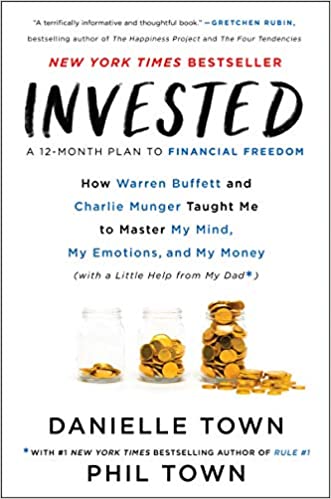Invested — Book Summary
Introduction
Danielle Town is the daughter of bestselling financial author Phil Town. Danielle ignored learning about investing throughout her growing age until she realized her money and life were getting out of control as she became a lawyer. To regain control over her finances, she asked her father to teach her value investing, the investment approach utilized by Warren Buffet and Charlie Munger. Phil Town agreed to take one year to teach her daughter to know how and when to invest in great companies.
An interesting quote from the book
Investing has created the deep happiness that comes from authentically making the life I want, and that happiness feels passionate, big, and free.
— Danielle Town, Invested
Summary of the book Invested
Becoming a skilled investor is the best means to achieve financial freedom. This can be achieved through skillful learning and applying investment principles used by people like Warren Buffet and Charlie Munger of Berkshire Hathaway, the world's most successful investors. Invest a year into learning principles and practices of value investing. Each month, take a step forward by applying what you've learned
January: Becoming Brave
This first month of the exciting journey is about acquiring the right motivation to start.
Danielle had always been advised and told about investing by her father Phil, a financial expert and author of "Rule #1", without taking heed. Having an exhausting month at her law offices made her realize her need for financial freedom. As a result, she willingly began her investing lessons.
Danielle's saving habit allowed Phil to start by helping her understand "Rule #1": Don't lose your money. Saving and hoarding cash doesn't look like ways of losing money, but they are. Due to inflation, money left to stagnate in the bank loses its value every year. Instead invest, because investments rise along with inflation.
Following Warren Buffet's style, Phil insists that a great way of investing is investing in a company with excellent growth potential over a decade and purchasing it at a bargain price.
Phil encouraged Danielle to continue on this path with the assurance that January is about being brave.
February: Knowing Your Number
February involves 'My Number's knowledge': The amount you require before you quit your job.
Danielle is made to understand that compounding means reinvesting the money you make, which will grow itself. Her dad takes her through her investment plan, taking compounding into account. If Danielle sells her home, pays her student loans, and invests all remaining, she will invest $40,000. If she lets that grow at a rate of 15% per year while investing $15,000 from her annual income and raising that investment by 5% per year as her yearly income grows, Danielle will be worth $615 million by the time she retires.
Phil further advises Danielle to aim at a 26% return per annum, which would make her double her initial capital in three years. This will make her stable in nine years hence leaving her job then. At the age of 95 years, she is estimated to have produced 7.3 billion dollars.
Phil summarizes the calculation with 'four mathematical components to achieving financial freedom': Minimum annual expenditure, years remaining to invest, money to invest, and required rate of return on the investments.
March: Voting for a Mission with Your Money
This chapter deals with how you're impacting the world and not just creating wealth. Investing in companies that operate according to your beliefs is as significant as investing in profitable companies. Since the money you invest acts as your vote, it will help you support what you have faith in. Writing down your values and how your spending is rising against society's values will improve it. Create your missions list, which helps in choosing the companies to invest in.
April: The First Principle of Value Investing
Charlie Munger was known for saying "yes" at the right time and similarly known for saying "no." Buffet calls him the "abominable no-man." Munger would only invest in a company if it met these standards:
- He must understand the company.
- Business must have fundamental features and durable that will keep it competitive throughout.
- The business's management has integrity and talent.
- The pricing of the company's shares must be reasonable and gives a Margin of Safety.
Research on companies that meet the four standards is vital, and if you search in the companies where your interests are, you'll have more fun doing it.
Picking where to invest, create a Venn diagram of competence labeled:
- What do I vote for with my money?
- What am I passionate about?
- Where do I make my money?
At the point where all those circles meet, you'll discover the industry you should focus on. The central fact is an issue that you know is profitable and you're interested in.
Phil advises Danielle to read more articles on value investing in understanding how gurus interpreted research content.
May: Munger's Moat and Management
In May, we learn Munger's second principle referred to as a Moat, the water trenched to surround a castle and act as a defensive measurer from invasion by enemies. The company had an essential competitive benefit that is long-lasting, which means it would consume many other companies' resources to out-do it.
Finding a company with a strong moat is not all that you need to do. You also need to research its management. Its management style, history, and origin. This is in line with Munger's third principle.
June: Circling Competence
The sixth month of the journey gets intimate to Danielle, for she has to meet her past relations with cash besides her family's history with money. Although she has an emotional uproar, she has a better relationship with Phil, her father. This helps her change her perspective and results in positive financial practices. Breaking your financial limits is the best you can do to change your previous relationships with money.
July: Charlie's Fourth Principle: Pricing
The last of Munger's principles is about the price of a business. Munger recommends three methods to determine whether the price of a venture is right for you:
- Ten caps: Helps understand if the amount of return you get annually is just about a minimum of 10%.
- Payback time: This the amount of time you require to have recovered the money invested.
- The margin of safety valuation.
August: Value
When you ask yourself whether you're buying stock in a company at a reasonable price, stick to the "margin of safety" rule. A margin of safety is a relatively simple idea. Look at the stock price in a company you're interested in and predict what the stock will be worth in 10 years.
Take that future stock price and shrink it by 15%, ten times – once for each year. This gives you a hypothetical value of what that stock could be priced at today. Is that theoretical number at least twice as large as what the price today is? That means the price currently on offer is a tremendous bargain.
September: Inverting the Story
Remember when you wrote the biography of the company you're interested in? Take that template but use it to convince yourself not to buy this company. This is called "inverting the story." Write down three fantastic reasons you want to buy the company and then invert each one of them, turning them into three reasons why purchasing this company is a terrible idea. Once you've inverted them once, invert them again! This brings you back to a positive answer — one that addresses the greatest of your concerns. Here is an example:
- Reason 1 to buy stock in Whole Foods: You trust the management.
- Reason 1 inverted: John Mackey, CEO of Whole Foods, is getting up there in age, and when he retires, the new management team is unlikely to be as talented as he is.
- Reason 1 re-inverted: At 65, John Mackey is not that old, and he loves his company so much that you don't see him leaving it in anyone else's hands anytime soon.
Do this exercise for the three companies you're most interested in. Be cruel and unbiased when you're inverting the story. The better reasons you come up with for not buying the company, the better the counters you'll have to come up with. If a company passes that test, you know you've got a winner.
October: Portfolios
Pick your favorite company, have a wish list, and draw your portfolio from which you will have a plan for how and when to invest.
November: When to sell
Set up a system by which you shall keep tracking your company of choice performance. Be ready to make a move when the time is right.
December: Pause and celebrate
You have learned a lot in the past 12 months. You have probably come a long way as you have learned to become an educated investor. Pause and celebrate progress.
Review of the book Invested
This book represents an attempt to redeem Warren Buffet and Charlie Munger's fame by repackaging their investment philosophy, coating it with a heart-warming story of a father and daughter, Phil and Danielle. However, the book does contain a useful overview of Investing philosophy and practical guidelines on how to begin learning the technical aspects of a company valuation. Investors who are beginners would know better from the primary sources; Warren Buffet and Charlie Munger.
Conclusion
'Invested' is a remarkable book to give readers tips on managing their finances and goals. Danielle outlines her financial journey, how other areas of her life are impacted, and the lessons that she learns about Investing. It enlightens anyone on why Investing is so crucial over savings and hoarding money and how to get started. My investing practice has helped me manage my finances in a manner that leaves me happy, comfortable, and geared towards my financial goals and hope for the future.
Once learning is finished, proceed to go and practice where you want it to be. Make an investment plan, have something you can acknowledge, and have a powerful skill to utilize that gives financial freedom. Start thinking about your finances differently
Don't miss the other book summaries on SunInMe.org

